Along with Dubrovnik, and possibly Split, the UNESCO World Heritage-listed Plitvice Lakes National Park is Croatia’s most visited tourist attraction. Situated 130km south of Zagreb, the national park is one of the largest and oldest in the country. It is renowned for its scenic lakes which are clustered in certain areas of the park and best viewed from above and/or via purpose-built wooden walkways that cut through and around the edge of the most accessible pools of water.
Although we did get a quick glimpse of one of the lakes, unlike the hordes of other visitors within the park boundaries, this wasn’t our reason for coming here. Our goal was an abandoned villa located deep in the forest above the lakes and after our, rather brief, gander at the park’s star attraction, we drove off along mountain roads in search of what we had come for.
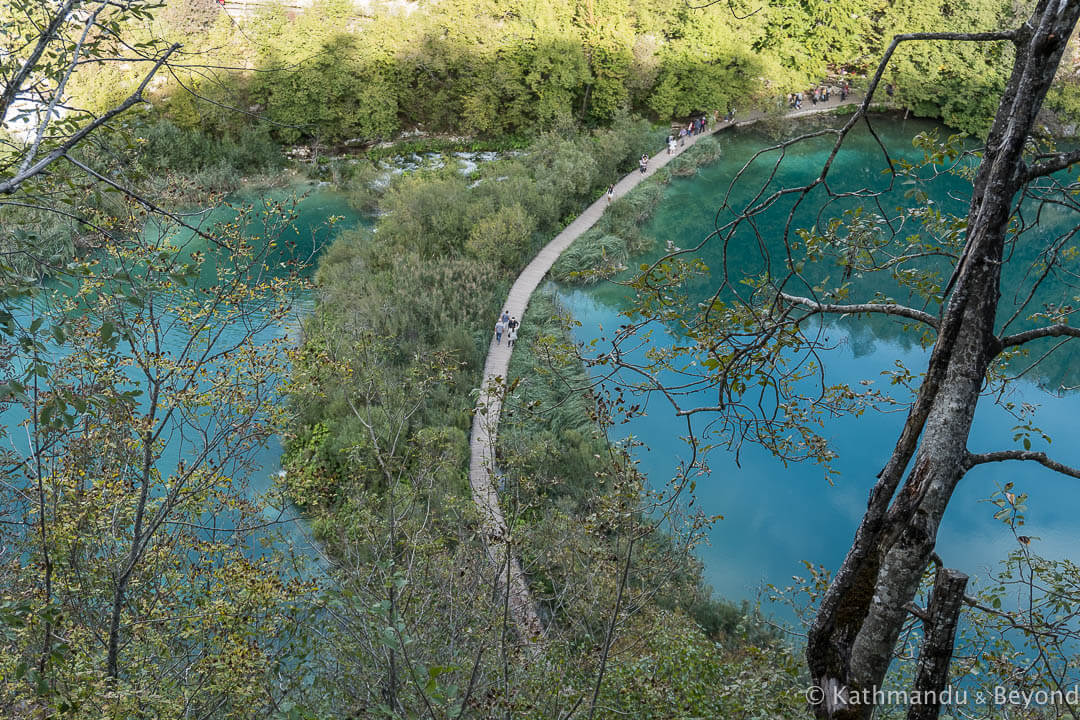 Plitvice Lakes National
Plitvice Lakes National
Finding Villa Izvor, as it is known, wasn’t difficult. The location of the villa is no secret – all you have to do is type Villa Izvor into Google Maps and, before you can blink, a little red/orange marker drops instantly onto the exact position. For the best part, roads are in very good condition in Croatia and even the little-used single-track path that wound its way through the woods on the final leg of our journey to locate the villa was OK and relatively pothole-free. In less than an hour after arriving in the region, we were parked outside a rather ominous-looking wood and stone structure, preparing ourselves for a spot of urban exploration.
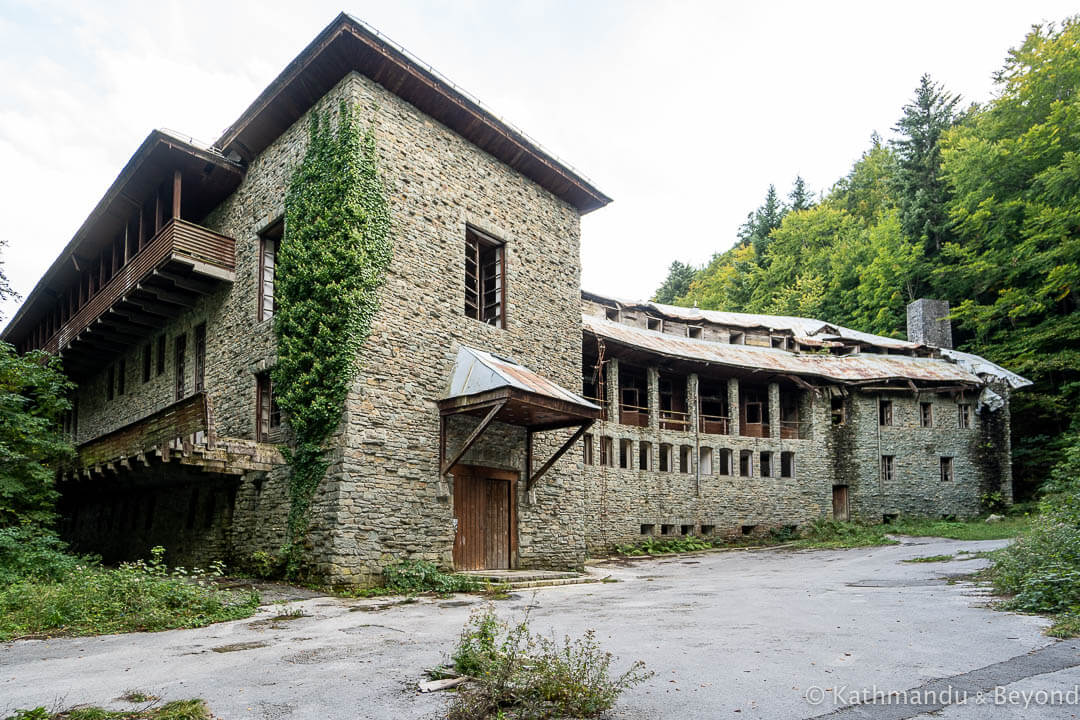 Villa Izvor
Villa Izvor
Villa Izvor – a short history
Villa Izvor was constructed as a summer retreat for the leader of the Socialist Federal Republic of Yugoslavia, Marshal Josip Broz “Tito”, as well as other members of the country’s political and military elite. As it turned out, Tito only stayed at the property a handful of time (between three and ten, according to sources I have read), presumably preferring some of the other opulent summer residences that he had scattered throughout various corners of the republic? His retreat on the Croatian Brijuni Islands, for example, where he often entertained many foreign heads of state, celebrities and other various dignitaries, or one of his villas near the central Bosnian town of Bugojno, which he would visit regularly in order to go hunting (*).
(*) For an insightful read about some of Tito’s properties and what’s became of them now, take a look at this article on Balkan Insight.
Facts about Villa Izvor on the Web are plentiful but sources do tend to contradict one another. Hence, some of the information detailed below might not be completely accurate but it does help give an impression of the history connected with the property.
It is generally considered that work on the villa started not long after the Second World War, as early as 1948, and was completed, and receiving its first guests in 1953. According to at least a couple of articles I have read, hundreds of prisoners were used as labourers to construct the villa. To begin with, I assumed they were World War II POWs, probably German or Italian, but actually, this doesn’t appear to be the case. The majority of the convicts were political opponents of the Yugoslav regime and many of the prisoners used were incarcerated at the notorious prison on Goli Otok, a barren island off the northern coast of the Adriatic Sea that was used as a penitentiary for political dissidents between 1949 and 1989. A grim place, because of the nature of its location and the maximum security surrounding it, the prison on Goli Otok was often dubbed ‘Croatian Alcatraz’.
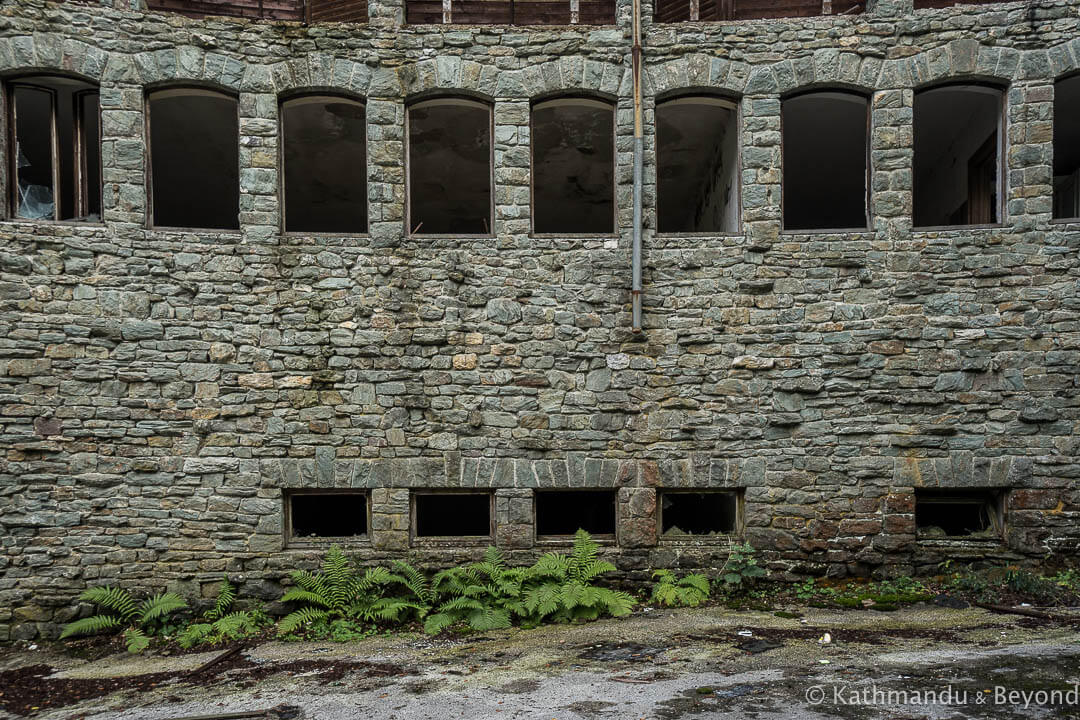 Villa Izvor
Villa Izvor
Villa Izvor was also known by the less appealing name of Object 99 by employees and some of those local to the area. There is a theory that the reason for this is that 99 prisoners died during the building of the villa but there is no way of knowing if this is true. What is known, however, is that no expense was spared during the villa’s construction and subsequent decking out. Green slate from Medvednica, a mountain in central Croatia, as well as rare wood were among the materials used in the construction of Villa Izvor and at the time of its completion, it was the most costly presidential residence built in the territory of Yugoslavia.
Almost nothing of this majestic grandeur remains today. The villa retained its original function up until the start of the Croatian War of Independence (part of the Yugoslav Wars) which began in March 1991 and lasted until November 1995. Although I can’t provide specific dates, during the conflict, Serbian rebels, who were loyal to the Serb-controlled Yugoslav People’s Army (JNA), reportedly occupied the villa. After the war was over, the property was first guarded by the Croatian National Guard (later to become the Croatian Army) and then staff from the Plitvice Lakes National Park.
It is believed that the residence, and its contents, remained in relatively good condition while the staff from the park were its custodians but they stopped doing this at some point in the early 2000s and it didn’t take long, thereafter, for the place to be heavily ransacked by looters and souvenir-hunters on the search for anything of value, of which there was probably quite a bit.
Our visit to Villa Izvor
As is our way, we sat in the car for a few minutes when we pulled up outside Villa Izvor in order to get a feeling for the lay of the land and work out if we were alone or not. It was deadly quiet and there was nobody around so we got out of the car and made our way towards the property.
The main edifice of the villa is flanked by two adjoining wings, giving it a U-shaped appearance if viewed from the air, or indeed Google Maps. Surprisingly for an abandoned location, we entered this one via its main front door; a heavy set of wooden double doors, the righthand one of which looked to us like it was permanently ajar and accessible. Once over the threshold, we were instantly greeted with a gruesome bit of abandoned building street art in the form of a purple-painted devil with an evil grin, yellow snakes for horns and another slivery creature coming out of its mouth. For a moment or so this distracted us from the large marble staircase in front that led up to a sweeping balcony that, in turn, gazed down on the villa’s main function hall. Even though it was stripped bare and part-covered in moss, the hall’s large colonnades and floor-to-ceiling windows told us this was once a very grand room indeed. This was where the party bigwigs, and no doubt high ranking officers from the JNA, would talk shop, decide the fate of Yugoslavia and enjoy whatever entertainment was laid on for them; no doubt all in equal measures.
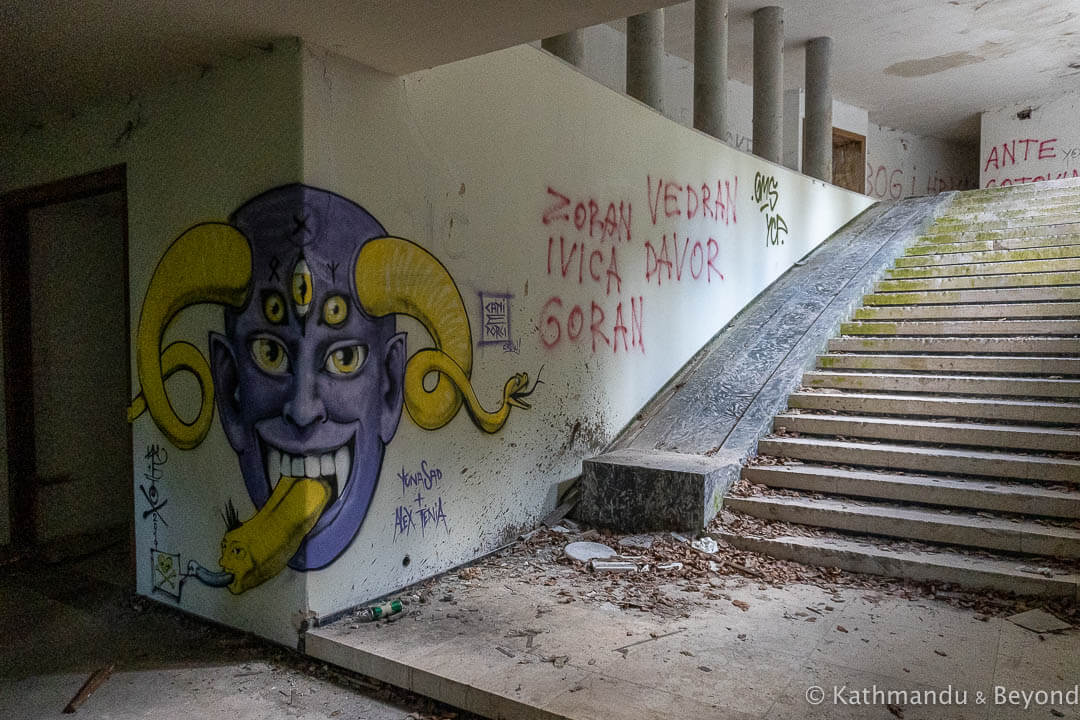 Street art inside the entrance to Villa Izvor
Street art inside the entrance to Villa Izvor
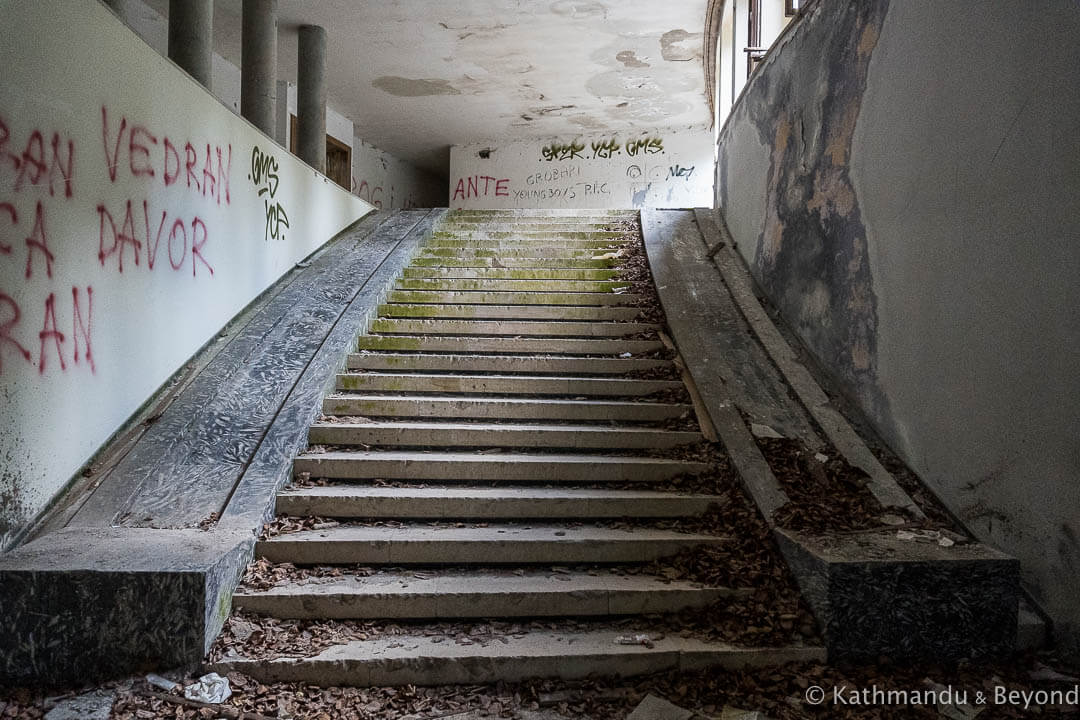
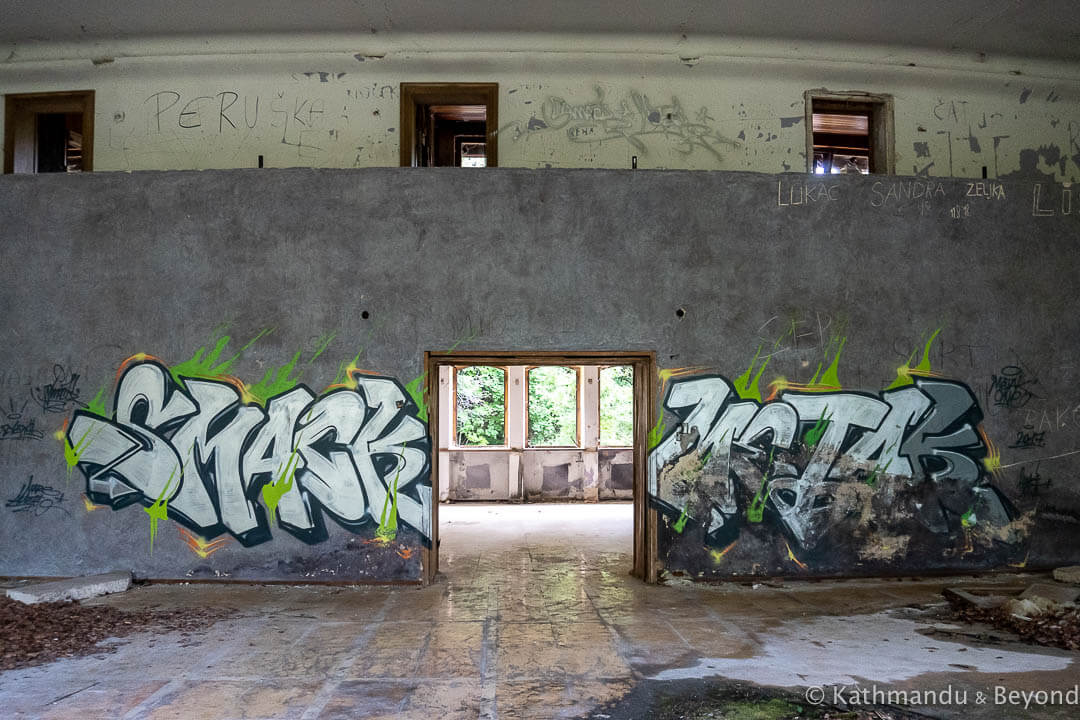
Marble staircase (left) and balcony (right) inside Villa Izvor
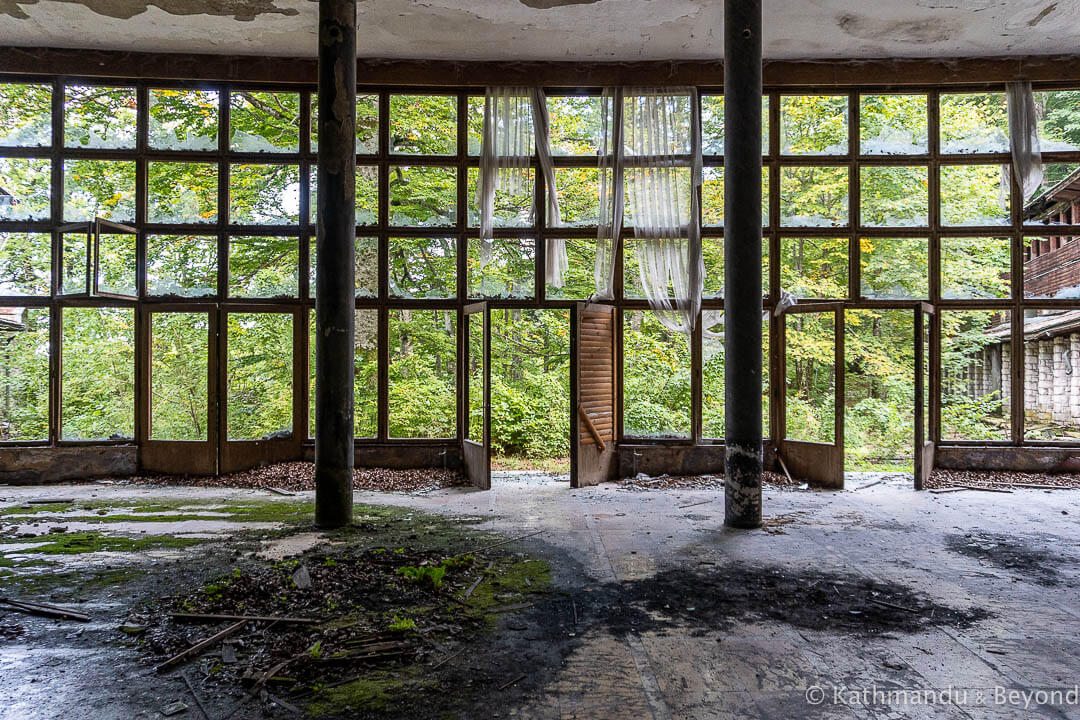 The main reception hall inside Villa Izvor
The main reception hall inside Villa Izvor
The main hall went directly out to the patio and what would have been the gardens beyond but we saved that for later, preferring instead to explore other parts of the interior first. We started in the northern wing, which was reserved for Tito’s use only (as opposed to the southern one which comprised twenty-odd suites for the other guests). We found the remains of a yellow carpet in one of Tito’s quarters but, apart from that there really was nothing left in any of the rooms besides the odd bit of debris and broken furniture that obviously wasn’t worth carting away. There was no question in our minds that, in this instance, the looters had done a thorough job of relieving the place of anything worthy of value.
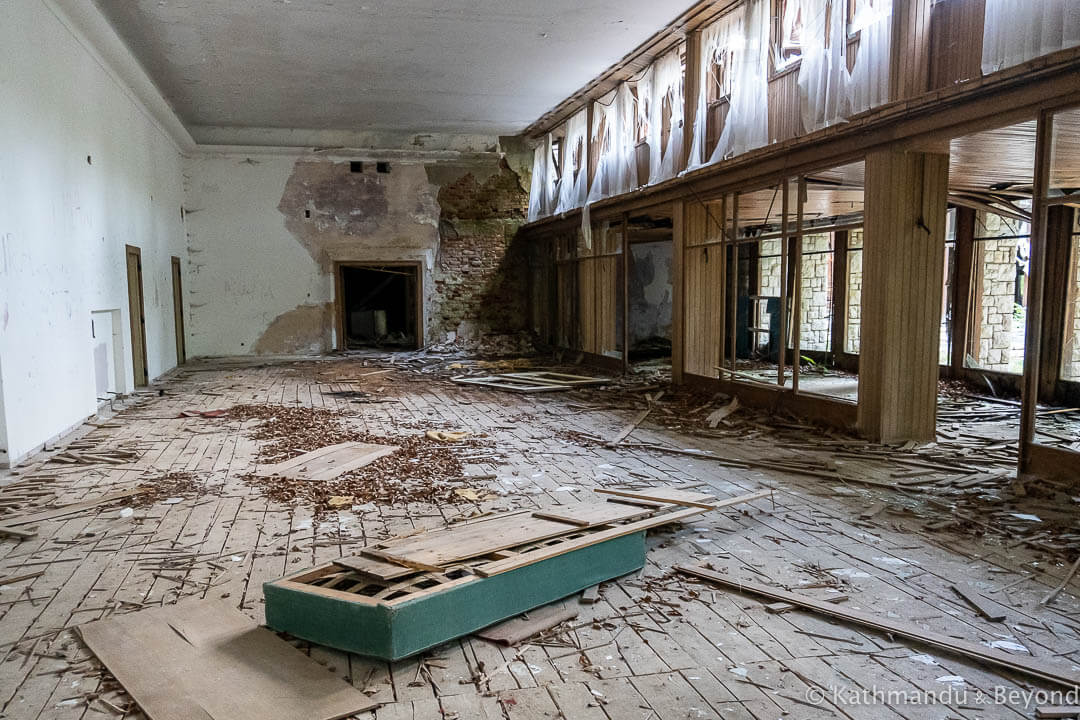 Villa Izvor
Villa Izvor
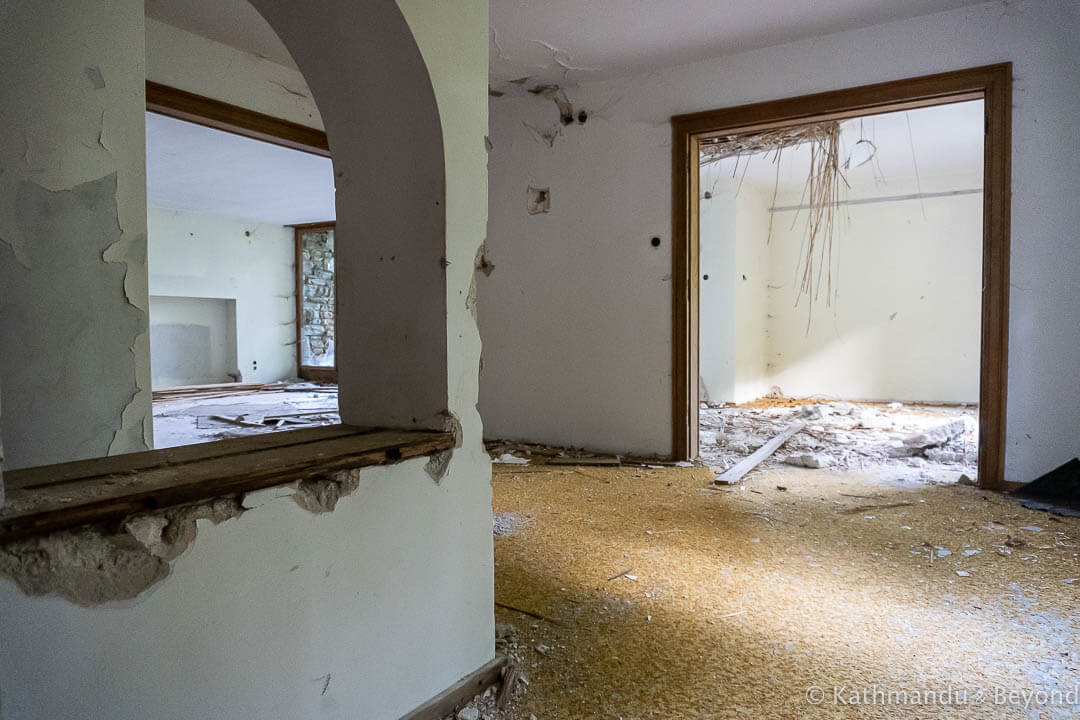
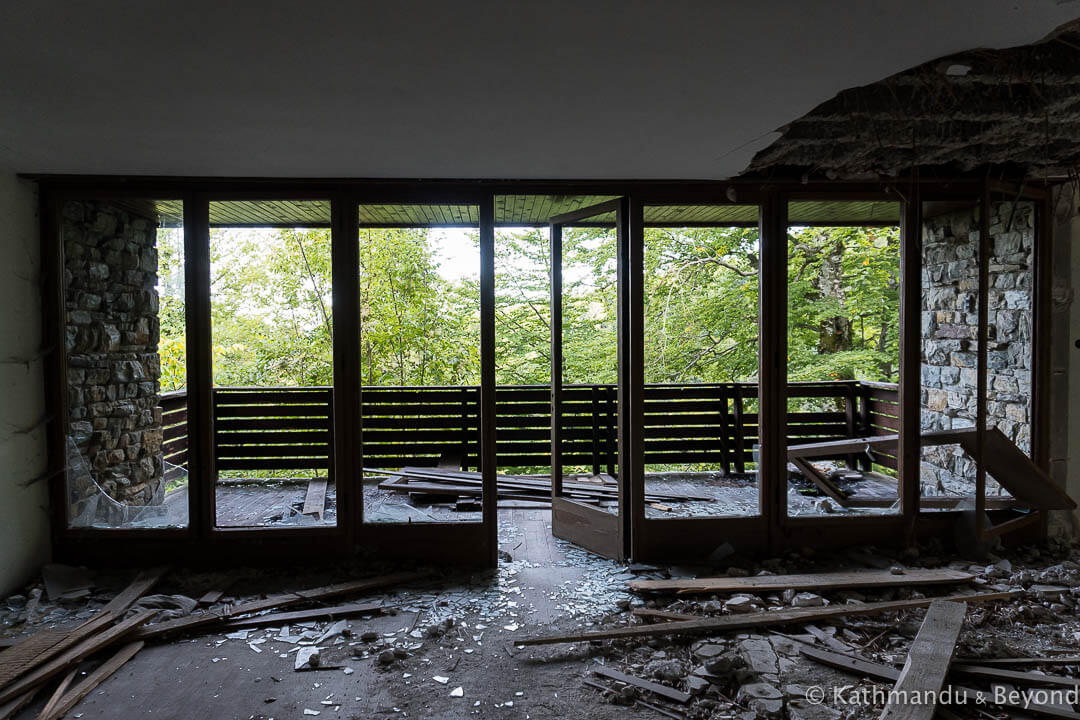
The northern wing/Tito’s quarters inside Villa Izvor
What’s more, much of the infrastructure within the building was in a perilous state of disrepair. This was especially evident with some of the external corridors and most of the balconies, which were made of (now rotten) wood and didn’t look like they would take the weight of a field mouse, let alone the likes of us so we gave them a wide berth.
During its heyday, the villa also boasted a bowling alley, a cinema, a billiard hall and a restaurant. Although we probably unknowingly ventured into what used to be the restaurant and the billiard hall, we didn’t find evidence of a cinema or a bowling alley and neither did we locate the tunnel which was connected to the villa and intended to be used as an escape route if necessary.
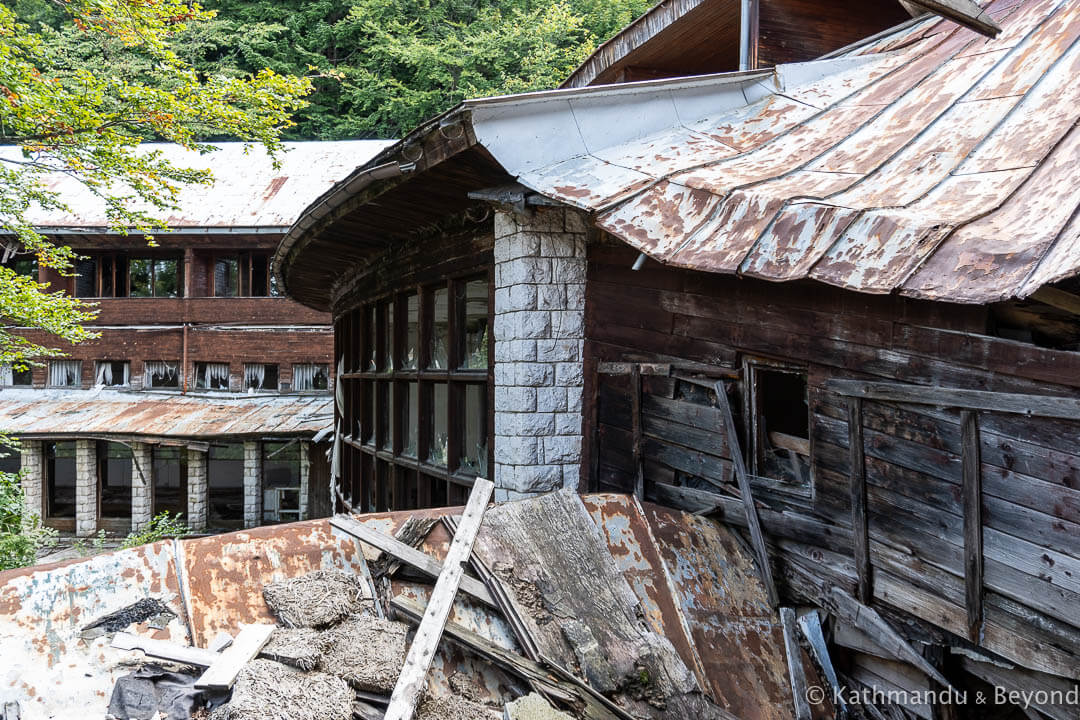 Villa Izvor
Villa Izvor
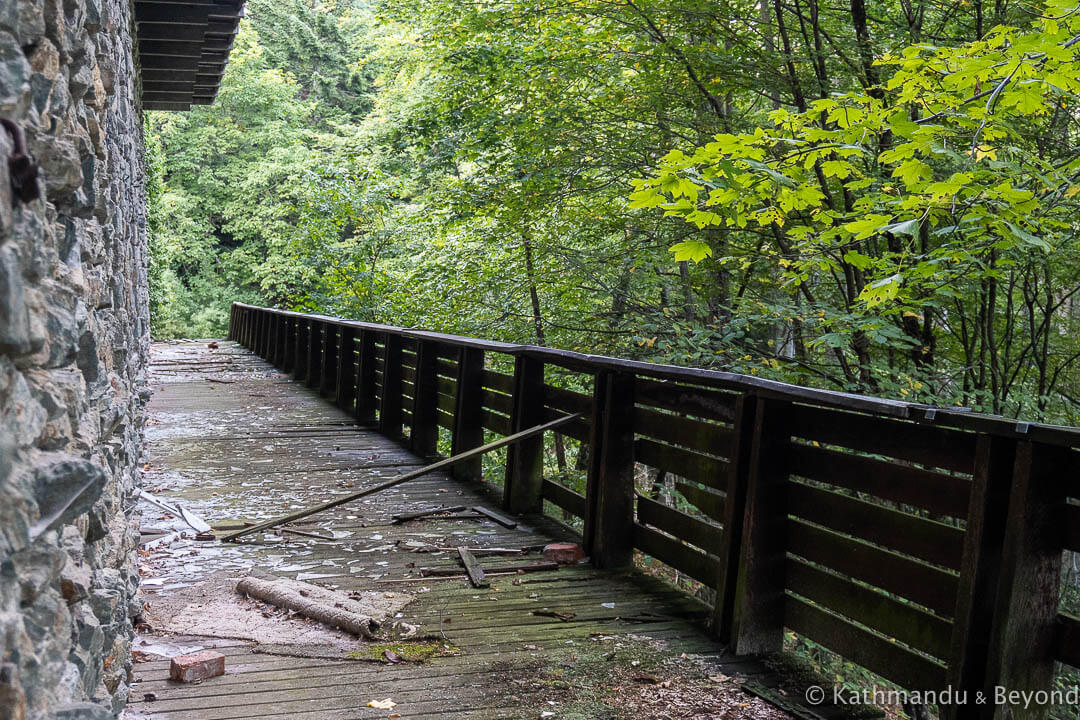
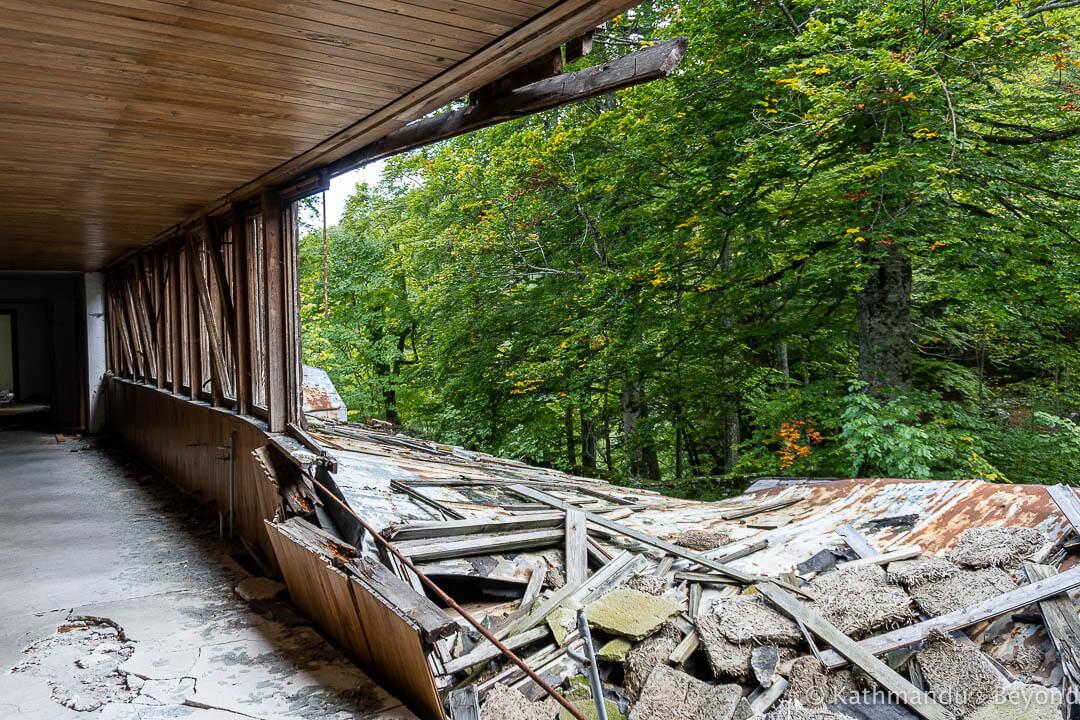
Villa Izvor
We also wandered around the grounds for a bit, where nature has most definitely taken over. Not that it’s obvious, but the villa is situated on a vertical cliff, 100 metres high, but not from any point within the grounds could we catch a glimpse of the lakes below. All we could see in every direction was dense forest and this struck us as rather peculiar. I would have thought the whole point of choosing an elevated spot in the national park would be to get some sort of view. Perhaps it isn’t possible to see the lakes from anywhere so distant, or maybe a lake view wasn’t as much of a priority as, say, seclusion (aka security)? I don’t know the answer and I haven’t been able to find out. We scouted quite a bit of the extended garden but didn’t find anywhere that could have once been a viewpoint down.
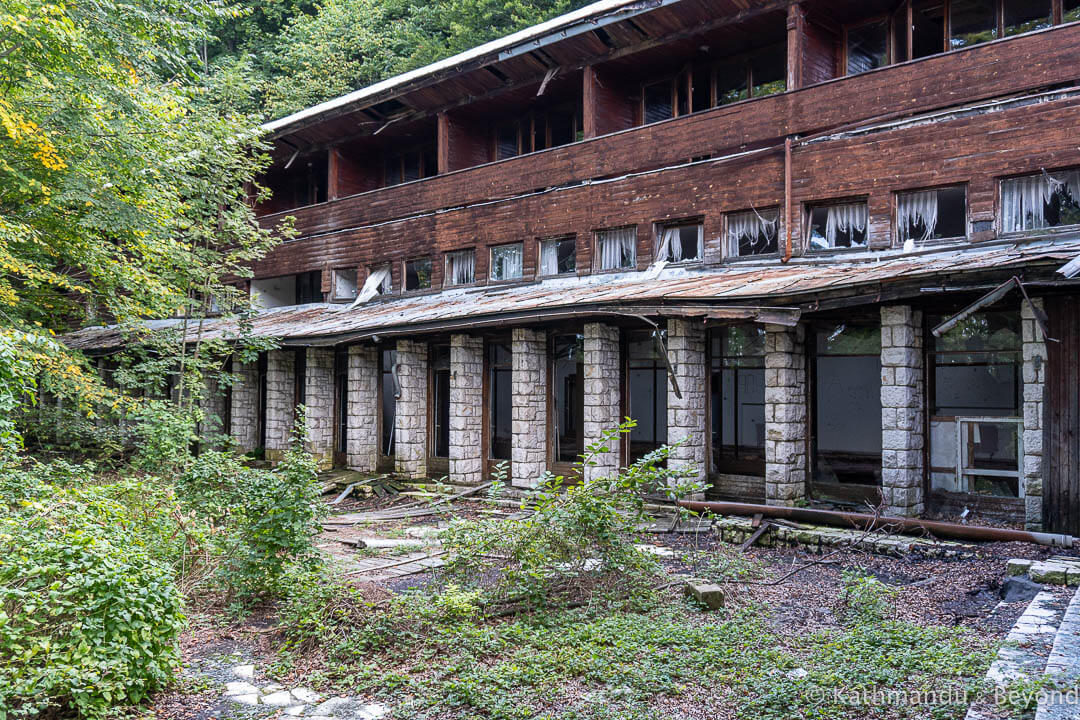 The patio outside Villa Izvor
The patio outside Villa Izvor
What is to become of Villa Izvor
In 2006, the then Croatian president, Stjepan “Stipe” Mesić, visited the Villa Izvor and vowed to renovate it to its former glory. Although it was listed as a property of significant cultural heritage as a result of his visit, the said-restoration never came to fruition. The 6,000 square-metre villa belongs to the state and they have tried to sell it off in recent times but without success. Turning it into a luxury hotel has been suggested. In 2015, the Croatian Ministry of Public Administration announced an initiative for private investment in one hundred state-owned properties, including Villa Izvor. According to this article, twenty-two private companies expressed an interest in putting money into renovating the villa but the idea was opposed by the Ministry of Environment and conservationists groups who argued it would be a threat to Plitvice Lakes National Park’s wildlife/ecosystem and, perhaps more importantly, its UNESCO World Heritage status.
Being awarded UNESCO status can bring in a large amount of revenue. Plitvice Lakes National Park received 1.8 million visitors in 2018. The current adult ticket price for peak season (June through to September) is €40 per person for a 1-day ticket and €16 per child. Admittedly, these figures drop to €10.80 and €4.70 respectively in the winter months but given most tourists visit in high season, that’s a lot of dosh that might be greatly reduced if the park couldn’t place the UNESCO banner above its door because it failed to adhere to the strict criteria laid down by the organisation. We touch more on this subject in our post entitled UNESCO World Heritage Sites: Backgrounder.
So, finally, the other option that is potentially on the cards is turning the villa into some sort of research centre, that would specialise in such things as karst topography and other phenomena associated with the park habitat/flora and fauna. Yet again, there is nothing firm to suggest this might happen. The only definite in all this speculation is the fact that what remains of the villa is in such bad shape, structurally, it’s going to take a serious amount of cash to restore it to its former glory. The only other alternative is to demolish it completely but I’m of the mind that that would be rather a shame …
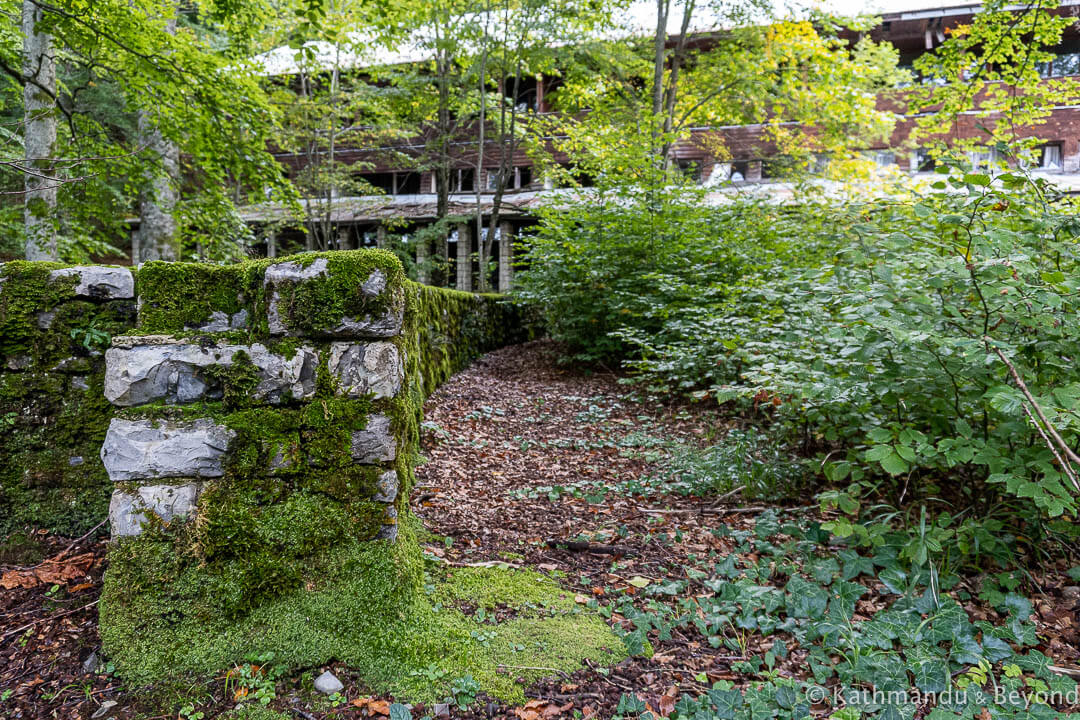 The backside of Villa Izvor
The backside of Villa Izvor
How to visit Villa Izvor
As I mentioned at the beginning of this post, the location of Villa Izvor is no secret but just in case, the GPS coordinates are 44.902780, 15.571763
You will need your own transport to get to Villa Izvor. First, you need to make your way to Fenomen Plitvice, an upmarket resort some distance from the lakes (GPS: 44.903881, 15.601895) (*). From this point, the single-track road that leads to the villa itself is obvious and the remaining distance is 4.2km. Even though it is uphill, cycling, and even walking could be an option from the resort. The distance from Plitvice Entrance 1 to Villa Izvor is 15km in total.
(*) It seems odd that there were objections to turning Villa Izvor into a hotel, yet Fenomen Plitvice, which was completed in 2018, was constructed just a few kilometres away.
Entrance fee for Villa Izvor
This seems like a strange subheading for an abandoned building (although it does sometimes happen) but we were concerned that we might have to pay the Plitvice Lakes National Park entrance fee (in our case €24.15 per person as we were there in October which is shoulder season) to get into the park boundaries and then onto the villa but this was not the case. You only have to pay the entrance fee if you want to visit the lakes.
READ MORE BLOG POSTS ABOUT CROATIA
DISCOVER MORE ABANDONED PLACES
IF YOU ENJOYED OUR POST ABOUT THE ABANDONED VILLA IZVOR, PLEASE SHARE IT…
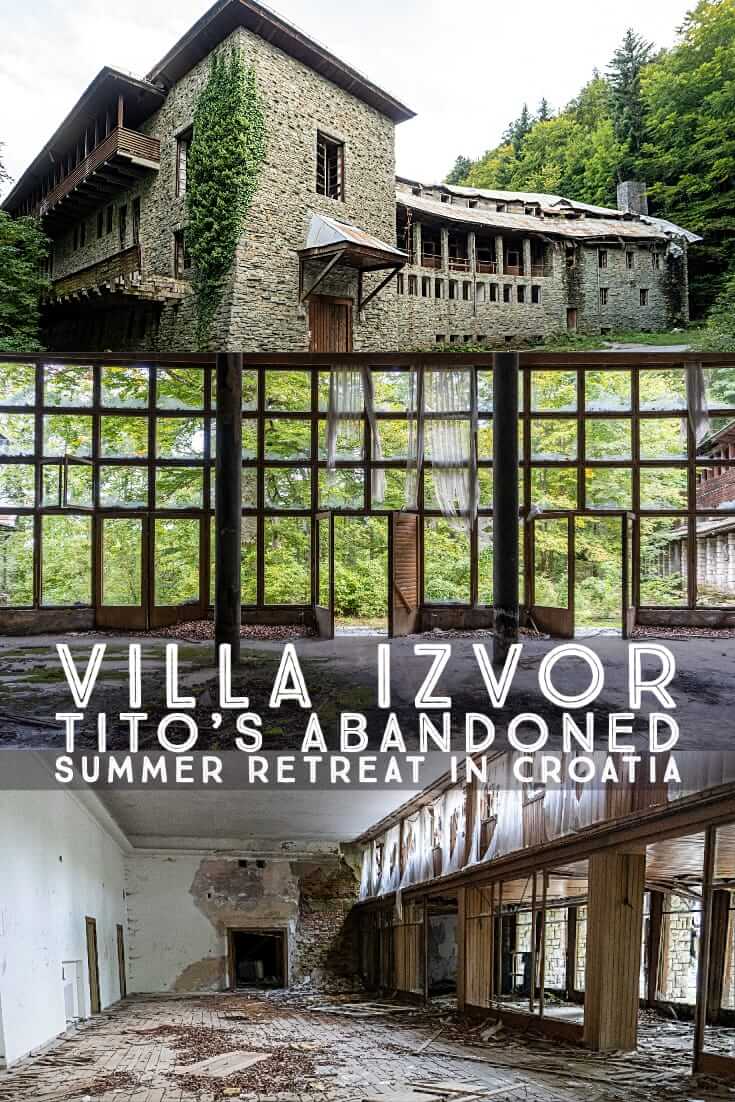
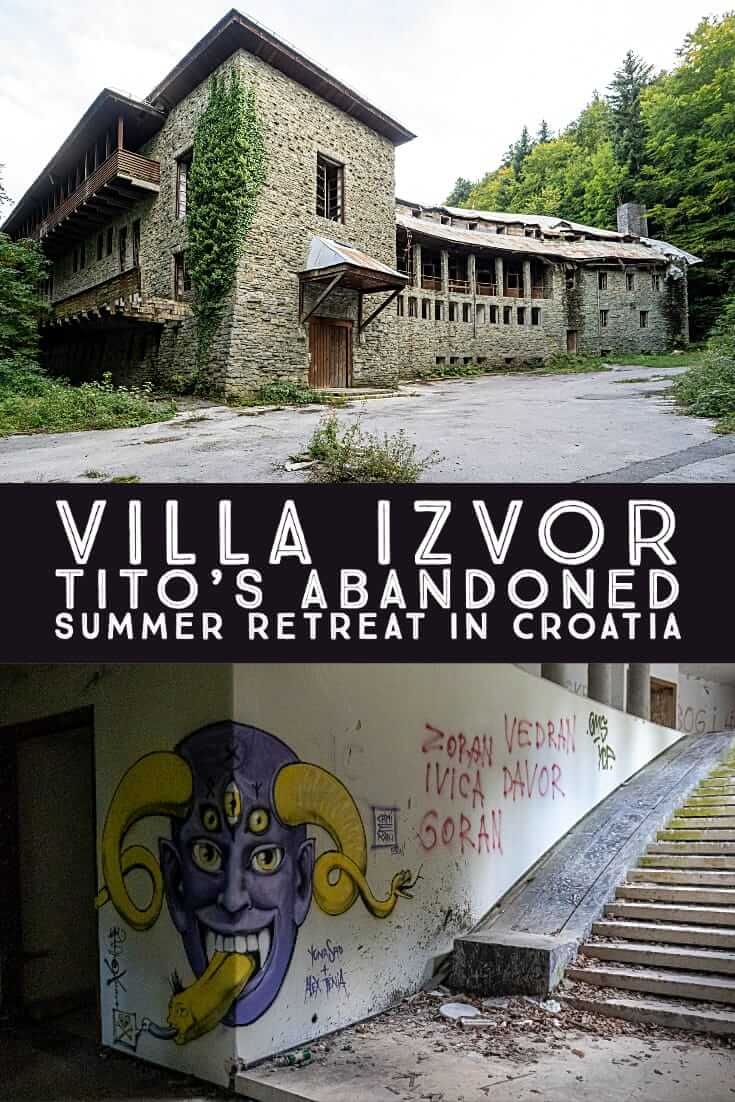
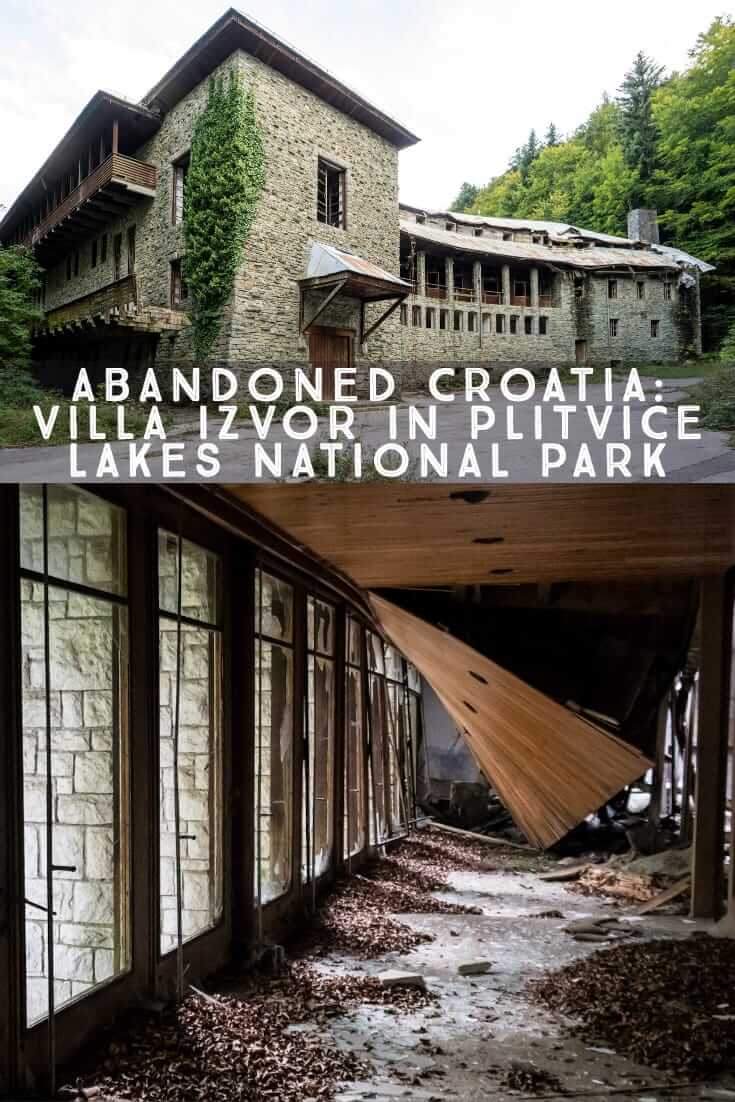

What a place. Pool tables still inside!
Yep, it’s a good one to explore! I assume the horrible street art is still located just before the main stairway!